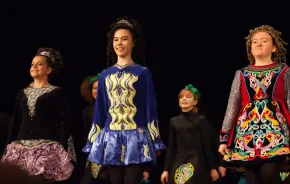 Recently a group of movie theaters in Sweden started grading films based on the “Bechdel Test.”
Recently a group of movie theaters in Sweden started grading films based on the “Bechdel Test.”
The test is a set of guidelines popularized by cartoonist Alison Bechdel that is often used to evaluate the representation of women in media. Lord of the Rings, Star Wars, and pretty much all of the Harry Potter movies fail the test, which says you have to have at least two (named) women who talk to each other about something other than a man.
Depending on your point of view, this may seem like a ridiculously low bar or a pointless exercise in trying to layer some measure of gender equality over an industry that is notoriously blind to how they treat women.
But while the test is far from perfect, it can provide an interesting perspective on the portrayal of women in popular culture. Children's movies present a challenge for the test because the lines begin to blur when you're dealing with non-human characters (cars, toys, dinosaurs, animals, etc.) but with parents so sensitive to gender roles these days the test can be an important starting point to examining what your children are watching.
Let's take two examples.
 Bambi doesn't pass the test. This blew my mind when I first realized its transgression. How could it not have at least two significant female characters? It does have at least two female characters, Faline (Bambi's girlfriend) and Bambi's mother, but as we all know, they don't get much opportunity to have a conversation. And everyone else with a significant speaking part is a boy.
Bambi doesn't pass the test. This blew my mind when I first realized its transgression. How could it not have at least two significant female characters? It does have at least two female characters, Faline (Bambi's girlfriend) and Bambi's mother, but as we all know, they don't get much opportunity to have a conversation. And everyone else with a significant speaking part is a boy.
A film like The Princess and the Frog offers more challenges. For example, does a conversation between Tiana and her mother that mentions her father in the context of Tiana's dream count as one of the the "no-man" conversations? And even though ultimately it passes the test can we be satisfied with the fact that Tiana's ultimate happiness is contingent on her relationship with the wastrel prince Naveen? As you layer the test over your family's favorite films it can generate interesting questions.
There are a number of resources online where you can find movies that have already been classified including bechdeltest.com. Check out the comments for lots of heated debate. Here are just a few examples that landed on either side of the fence.
10 films that pass the test
Brave (rated PG): Scores big points for its dynamic relationship between mother and daughter, which is the major theme of the movie. Merida has key confrontations with both her mother Elinor and the Witch (who is not named but is a significant female character).
Cinderella (rated G): She's working her way toward Prince Charming but her relationship with the wicked step-family is what this movie is all about. Cinderella, Lady Tremaine, Drizella, Anastasia and the Fairy Godmother all talk about, well, the Ball, which is not directly about Prince Charming.
The Incredibles (rated PG): This superhero family drama offers several good opportunities for Helen and Violet to have heartwarming mother-daughter conversations about using your super powers and protecting your secret identity. Dash is there too but he doesn't intrude overtly on Helen and Violet's connection. Helen also gets to talk superhero fashion with Edna.
Lilo and Stitch (rated PG): The first time I watched Lilo and Stitch I was impressed that they focused so much of the story on Lilo and Nani's difficult sibling relationship and their struggles to stay together despite the loss of their parents. This one clearly passes all the criteria and next to Brave is one of the stronger female-driven films.
 Mulan (rated PG): Mulan is probably the best Disney Princess role model but much of her story revolves around her excelling in a male-dominated military environment. Does the context, which doesn’t provide much opportunity for interaction between significant female characters, make the film any less important as an object lesson on the strength and value of women in society?
Mulan (rated PG): Mulan is probably the best Disney Princess role model but much of her story revolves around her excelling in a male-dominated military environment. Does the context, which doesn’t provide much opportunity for interaction between significant female characters, make the film any less important as an object lesson on the strength and value of women in society?
Robin Hood (rated G): There are lots of versions of Robin Hood. I would like the classic Errol Flynn Adventures of Robin Hood to pass the test but it doesn't quite make it. The one here is the Disney-animated version where Maid Marian and Lady Kluck have a spirited conversation during a game of badminton.
The Princess and the Frog (rated G): Tiana and her mom, Eudora, Tiana and Mama Odie, Tiana and Charlotte - well, that last one is stretching it but there's still plenty to pass the test. As noted above, while Tiana is a fantastic role model the Naveen factor still bothers me.
Tangled (rated PG): Rapunzel and Mother Gothel have enough interaction to help Tangled easily pass the test. It doesn't hurt that Rapunzel gets to do her fair share of saving the day. But the Internet commenters can still find things to get upset about - go ahead, get angry!
101 Dalmatians (rated G): The original 1961 animated version squeaks by with Cruella discussing purchasing the puppies with Anita. The 1996 live action version with Glenn Close as Cruella DeVil manages to squeak by with Cruella discussing fashion with Anita. Either way, it's a squeaker.
Bolt (rated PG): Does Bolt pass all three, or just two of the criteria? That hinges on your perception of Bolt as a dog or a male character. Penny and her mother (unnamed) discuss Penny's feelings about how much she misses Bolt. This one really pushes the line.
Films that don't pass the test
The Little Mermaid, The Lion King, Up, Finding Nemo, Aladdin, The Jungle Book, Lady and the Tramp, Meet the Robinsons, Monsters Inc., Toy Story
Do you agree or disagree with any of these selections? Do you have a movie that is a good example one way or the other? Do you think the test is bogus? Here's our chance for a debate in the comments section.
Let us know what you think!
 About the author: John Kubalak is a writer, teacher, volunteer coordinator, raconteur, and scalawag. He does not publish science fiction under the pseudonym Jonathan Black but he does publish a monograph on fatherhood, The Eclectic Dad. He has a son, a daughter, a beautiful wife (and a little dog too!) who are adorable, maddening, zany, and brilliant all at the same time.
About the author: John Kubalak is a writer, teacher, volunteer coordinator, raconteur, and scalawag. He does not publish science fiction under the pseudonym Jonathan Black but he does publish a monograph on fatherhood, The Eclectic Dad. He has a son, a daughter, a beautiful wife (and a little dog too!) who are adorable, maddening, zany, and brilliant all at the same time.











